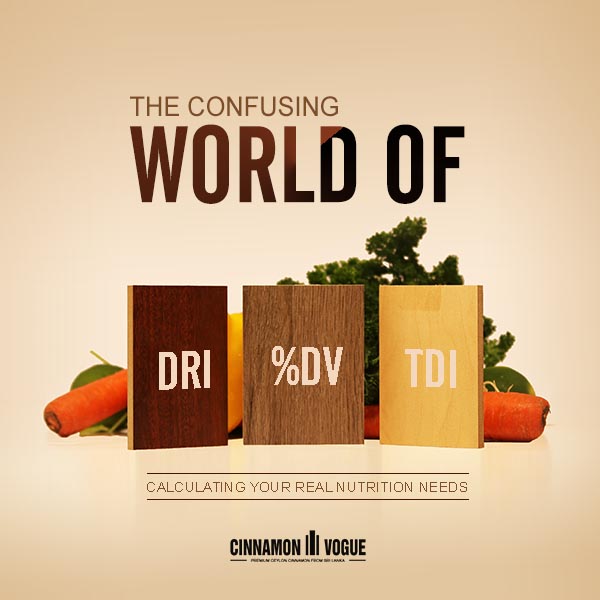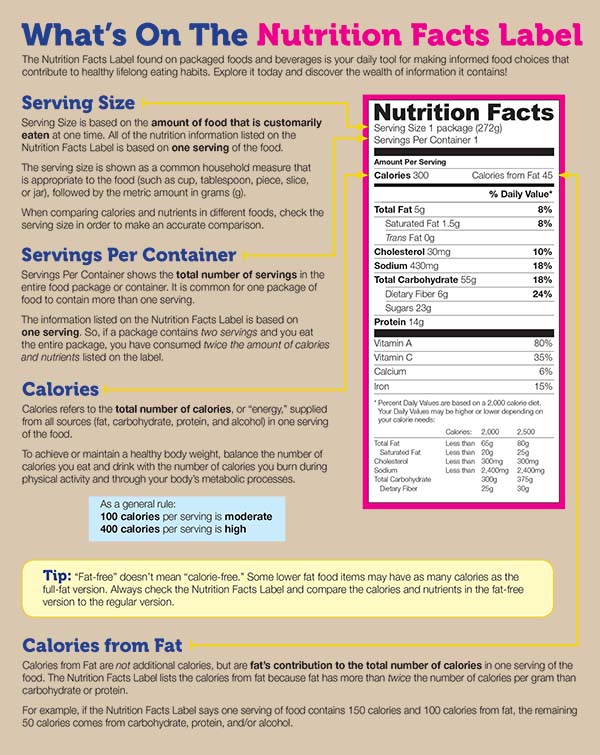Ever wonder what the difference us between RDI, %DV and TDI mean. For most people these values can be confusing so we went in a quest to find out. Not all of us are the same.Calculating the nutrients needs for your personal situation is unique to you.
DRI (Dietary Reference Intakes) establishes the guidelines on a wide variety of essential vitamins, minerals and nutrient you need. The Dietary Reference Intakes (DRIs) are developed and published by the The National Academy of Medicine (IMAP), formerly called the Institute of Medicine, is an American nonprofit, non-governmental organization. To prevent conflicts of interest, IMAP does not accept funding from the pharmaceutical, medical device, or tobacco industries.
%DV (Daily Value) in comparison tells you how much of the nutrients you’re actually getting from the foods you eat. For example from a packet of frozen pasta or a can of tuna fish. This % DV are calculated by the FDA using data from the DRI and the food item in question.
SO WHAT ARE DRI’s
The DRIs (Dietary Reference Intakes) represents the most current scientific knowledge on nutrient needs of a healthy populations. DRIs makes recommendations based on age, sex, height, weight and activity level.
For example, let’s look at an adult male aged 64, with a height of 5’.9”, a weight of 208lb and a sedentary activity levels. Using this handy calculator at the USDA web site we can calculate his nutrient needs as follows;
| MACRO NUTRIENTS- RECOMMENDED DAILY INTAKE | ||
| Body Mass Index (BMI) | 30.9 | |
| Estimated Daily Caloric Needs | 2501 kcal/day | |
| Carbohydrate | 281-406 g (10-14oz) | |
| Total Fiber | 30 grams (1oz) | |
| Protein | 76 grams (2.65oz) | |
| Fat | 56 – 97 grams (2-3.42 oz) | |
| Saturated fatty acids | As low as possible while consuming a nutritionally adequate diet. | |
| Trans fatty acids | As low as possible while consuming a nutritionally adequate diet. | |
| Linolenic Acid | 1.6 grams | |
| Linoleic Acid | 14 grams | |
| Dietary Cholesterol | As low as possible while consuming a nutritionally adequate diet. | |
| Total Water (incl food) | 3.7 Liters (about 16 cups) | |
| VITAMINS | ||
| RDI | DTI | |
| Vitamin A | 900 mg | 3000 mg |
| Vitamin C | 90 mg | 2000 mg |
| Vitamin D | 15 mg | 100 mg |
| Vitamin B6 | 1.7 MG | 100 mg |
| Vitamin E | 120 mcg | ND |
| Thiamin | 1.2 mg | ND |
| Vitamin B12 | 2.4 mcg | ND |
| Riboflavin | 1.3 mg | ND |
| Folate | 400 mcg | 1000 mcg |
| Niacin | 16 mg | 35 mg |
| Choline | 0.55 g | 3.5 g |
| Pantothenic Acid | 5 mg | ND |
| Biotin | 30 mg | |
| Carotenoids | N/A | ND |
| MINERALS | ||
| Calcium | 1000 mg | 2000 mg |
| Cloride | 2g | 3.6 g |
| Chromium | 30 mcg | ND |
| Copper | 900 mcg | 10000 mcg |
| Floride | 4 mg | 10 mg |
| Iodine | 150 mcg | 1100 mcg |
| Iron | 8 mg | 45 mg |
| Magnesium | 420 mg | 350 mg |
| Manganese | 2.3 mg | 11 mg |
| Molybdenum | 45 mcg | 2000 mcg |
| Phosperous | 0.7 g | 4g |
| Potassium | 4.7g | ND |
| Selenium | 55 mcg | 400 mcg |
| Sodium | 1.3 g | 2.3g |
| Zinc | 11 mg | 40 mg |
As you can see the Dietary Reference Intakes (DRI) gives you a much better picture of what you need to eat based on your gender, age, weight and activity levels. But this is by no means the complete solution. The male in this example has a BMI of 30.9. That means he needs to lose weight and adjust his calorie intake accordingly while maintaining his nutrient needs. When people cut their calories intake, the also lose nutrients. The trick is to cut the calories without losing vital nutrients. Unfortunately the RDI does not take current trends and scientific evidence into account. For example there increasing evidence that eating good fats like coconut oil, grass fed better, Pork Belly will help you lose weight, keep you satiated for longer with no risk of it leading to bad cholesterol. Interestingly the RDI does not include sugar as a vital ingredient which is a good thing.
Now imagine this adult male will go on a Keto diet. Using this Keto calculator he should eat this
- 1939 calories
- 156 g fats
- 20 g carbs
- 115 g protein
Notice the wide difference between the DRI calculations for protein, fats and carbs?. It has now been clearly established that high carbs at the levels DRI recommends is dangerous, especially for those with diabetes. The protein levels DRI recommends also seem unusually low because even the Keto diet recommends 115g of protein while the DRI recommends 76g in this example. Of course the Keto diet is a radical diet and should only be used temporarily for the most part because people are simply unable to get the minimum amount of vital minerals and vitamins unless they are super disciplined. When you are on a Keto diet, it is vitally important you try to get the vitamin and minerals recommended by the DRI, even if that is a somewhat flawed concept. Failure to do that lead to other health complications. Which is why many Keto dieters supplement with electrolytes.
DAILY TOLERABLE INTAKE
The daily tolerable intake is the upper limit of nutrients you should take. This is a useful guide since many people have gotten into the habit of taking huge amounts of vitamins pills. Take too much and your body might suffer from toxic shock. Personally we feel that you should get all your nutrients from real food and not pills which can be corrosive on your stomach lining over time. In many cases vitamin pills contain very little of the nutrition they claim to have. They may be good as temporary solution provided they are of high medical grade quality, but long term it cannot be good. Your body was not designed to take tablets. Vitamins and minerals need to be slow absorbed.
How about DV%
The Daily value percentages you see in food packages is only a very rough guide. Because DRI’s contain too much information to include on the nutrition facts label, the FDA uses information from the DRIs to create a single number called the % Daily Value (DV%) based on 2,000 and 2500 calorie-a-day diet for covers 97-98% of people over the age 4 and above. (Click here for PDF of FDA dv% guide)
The Daily Value (%DV) shows how much of a nutrient is in one serving of the food. The %DVs are based on the Dietary Reference Intake values for only a few selected data (calories, fat, saturated fat, trans fat, cholesterol, sodium, total carbohydrate, dietary fiber, sugars, proteins, Vitamin A, C, Calcium and Iron), recommended per day for Americans 4 years of age and older. The %DV column doesn’t add up vertically to 100%. Instead, the %DV is the percentage of the Daily Value for each nutrient in one serving of the food.
For example, if the Daily Value for saturated fat is 20 grams (g), which equals 100% DV. and the Nutrition Facts Label says one serving of a food contains 1.5 g of saturated fat, then the %DV for saturated fat for this specific food is 8%. That means the food contains 8% of the maximum amount of saturated fat that an average person should eat in an entire day.
CONCLUSION
So there you have it. Government recommendation or even non profit recommendation is not the be all and end ALL. They have proven to be wrong many times, as was the case with food pyramid, fat recommendations, salt recommendation or dismissing the dangers of sugar, GMO crops and pesticide use. Private industry also tries to manipulate us with fake research and data. Still these nutrition guidelines are a good starting point for us, as long as we use it wisely without being overly enamored of it. Eat real food. Cut the sugar. Exercise a little. Practice intermittent fasting.


